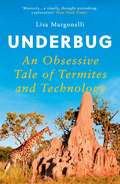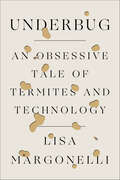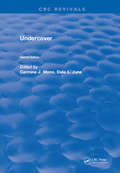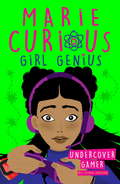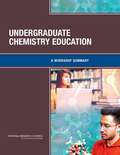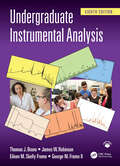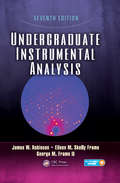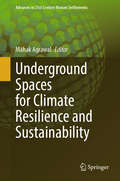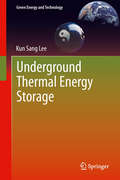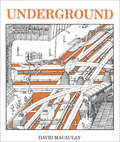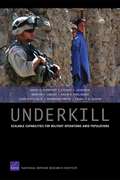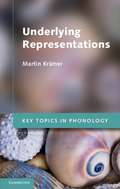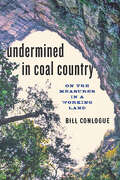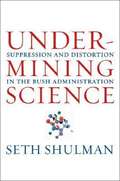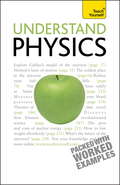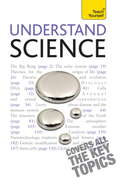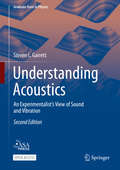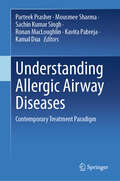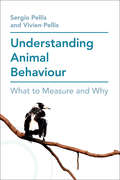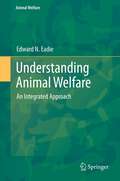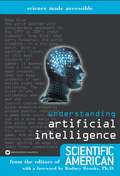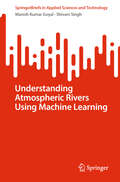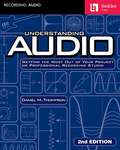- Table View
- List View
Underbug: An Obsessive Tale of Termites and Technology
by Lisa MargonelliWho has the answer to the world&’s fuel problems? How can we bring ruined land back to life? Where do roboticists turn when they try to engineer a hive mind? Termites. Strange though it may seem, scientists are looking to these much-reviled insects as little guides to the biggest of ideas. Lisa Margonelli follows them to find out how termites could change the world. A masterpiece of popular science, Underbug touches on everything from metaphysical meditation, technological innovation and the psychology of obsession to good old-fashioned biology.
Underbug: An Obsessive Tale of Termites and Technology
by Lisa Margonelli“Margonelli takes us on a termite-guided exploration of subterranean tracts of nature, science, and robotics. The book is brimming with flair.” ―Peter Godfrey-Smith, author of Other MindsThe award-winning journalist Lisa Margonelli, national bestselling author of Oil on the Brain: Petroleum’s Long, Strange Trip to Your Tank, investigates the environmental and economic impact termites inflict on human societies in this fascinating examination of one of nature’s most misunderstood insects.Are we more like termites than we ever imagined? In Underbug, the award-winning journalist Lisa Margonelli introduces us to the enigmatic creatures that collectively outweigh human beings ten to one and consume $40 billion worth of valuable stuff annually—and yet, in Margonelli’s telling, seem weirdly familiar. Over the course of a decade-long obsession with the little bugs, Margonelli pokes around termite mounds and high-tech research facilities, closely watching biologists, roboticists, and geneticists. Her globe-trotting journey veers into uncharted territory, from evolutionary theory to Edwardian science literature to the military industrial complex. What begins as a natural history of the termite becomes a personal exploration of the unnatural future we’re building, with darker observations on power, technology, historical trauma, and the limits of human cognition.Whether in Namibia or Cambridge, Arizona or Australia, Margonelli turns up astounding facts and raises provocative questions. Is a termite an individual or a unit of a superorganism? Can we harness the termite’s properties to change the world? If we build termite-like swarming robots, will they inevitably destroy us? Is it possible to think without having a mind? Underbug burrows into these questions and many others—unearthing disquieting answers about the world’s most underrated insect and what it means to be human.
Undercover
by Dale L. June Carmine J. MottoAn instructive and entertaining book for those public and private investigators who are potential undercover agents, this book approaches the topic from three angles: how to handle informants, how to investigate suspects, and how to be an undercover agent. Undercover places emphasis on the law enforcement agent but does not overlook the private investigator who may be assigned to work in an undercover role in business or industry.The first edition of this book quickly became the classic text for a whole generation of law enforcement personnel, and the name Carmine Motto, now retired from the secret service, is known throughout the country. Both authors contribute years of personal experience and use actual case anecdotes to focus attention on the triangle of interpersonal relationships among the informant, the suspect and the investigative agent. The motivations of the informant are detailed and analyzed to determine his reasoning and willingness to assist the investigator; the suspect is examined relative to his background, associates and capabilities; and, the investigative agent is instructed in protecting the identities of and handling of informants while gaining the confidence of the suspect. This edition of Undercover modernizes the writing, replaces the photographs, and updates the cases to provide insight into the highly intriguing and fascinating human intelligence and evidence gathering method that has captured the public's attention through movies, television and newspapers.
Undercover Gamer: Book 3 (Marie Curious, Girl Genius #3)
by Chris Edison50% Girl + 50% Genius = 100% Awesome!A brilliant new series with a heroine who uses her smarts - and her girl squad - to save the world from evil, one invention at a time.Marie's apprenticeship with tech giant Sterling Vance has already been a crazy adventure, from saving the world from a deadly computer virus to rescuing a global pop star, Marie thought she'd seen it all. But now Marie must face her most difficult challenge yet - going undercover!When Vance invests in a multi-million dollar eSports tournament,Marie and her three best friends are sucked into the world of professional gaming. Glitzy parties, infinity pools and the latest tech are all at their fingertips but when Vance discovers that someone in the tournament is cheating, it's left to Marie to infiltrate the GAME House where all the top gamers live, and find the culprit.The third installment in the Marie Curious, Girl Genius series sees Marie and her brainiac friends travel to Beijing, China!
Undergraduate Chemistry Education
by National Research Council Chemical Sciences Roundtable Division on Earth and Life Studies Joe Alper Board on Chemical Sciences and Technology Keegan SawyerUndergraduate Chemistry Education is the summary of a workshop convened in May 2013 by the Chemical Science Roundtable of the National Research Council to explore the current state of undergraduate chemistry education. Research and innovation in undergraduate chemistry education has been done for many years, and one goal of this workshop was to assist in the transfer of lessons learned from the education research community to faculty members whose expertise lies in the field of chemistry rather than in education. Through formal presentations and panel discussions, participants from academia, industry, and funding organizations explored drivers of change in science, technology, engineering and mathematics education; innovations in chemistry education; and challenges and opportunities in chemistry education reform. Undergraduate Chemistry Education discusses large-scale innovations that are transferable, widely applicable, and/or proven successful, with specific consideration of drivers and metrics of change, barriers to implementation of changes, and examples of innovation in the classroom.
Undergraduate Instrumental Analysis
by James W. Robinson Thomas J. Bruno Eileen M. Skelly Frame George M. Frame IIAnalytical instrumentation is crucial to research in molecular biology, medicine, geology, food science, materials science, forensics, and many other fields. Undergraduate Instrumental Analysis, 8th Edition, provides the reader with an understanding of all major instrumental analyses, and is unique in that it starts with the fundamental principles, and then develops the level of sophistication that is needed to make each method a workable tool for the student. Each chapter includes a discussion of the fundamental principles underlying each technique, detailed descriptions of the instrumentation, and a large number of applications. Each chapter includes an updated bibliography and problems, and most chapters have suggested experiments appropriate to the technique. This edition has been completely updated, revised, and expanded. The order of presentation has been changed from the 7th edition in that after the introduction to spectroscopy, UV-Vis is discussed. This order is more in keeping with the preference of most instructors. Naturally, once the fundamentals are introduced, instructors are free to change the order of presentation. Mathematics beyond algebra is kept to a minimum, but for the interested student, in this edition we provide an expanded discussion of measurement uncertainty that uses elementary calculus (although a formula approach can be used with no loss of context). Unique among all instrumental analysis texts we explicitly discuss safety, up front in Chapter 2. The presentation intentionally avoids a finger-wagging, thou-shalt-not approach in favor of a how-to discussion of good laboratory and industrial practice. It is focused on hazards (and remedies) that might be encountered in the use of instrumentation. Among the new topics introduced in this edition are: • Photoacoustic spectroscopy. • Cryogenic NMR probes and actively shielded magnets. • The nature of mixtures (in the context of separations). • Troubleshooting and leaks in high vacuum systems such as mass spectrometers. • Instrumentation laboratory safety. • Standard reference materials and standard reference data. In addition, the authors have included many instrument manufacturer’s websites, which contain extensive resources. We have also included many government websites and a discussion of resources available from National Measurement Laboratories in all industrialized countries. Students are introduced to standard methods and protocols developed by regulatory agencies and consensus standards organizations in this context as well.
Undergraduate Instrumental Analysis, Seventh Edition
by James W. Robinson Eileen Skelly Frame George M. FrameCrucial to research in molecular biology, medicine, geology, food science, materials science, and many other fields, analytical instrumentation is used by many scientists and engineers who are not chemists. Undergraduate Instrumental Analysis, Seventh Edition provides users of analytical instrumentation with an understanding of these instruments, covering all major fields of modern instrumentation. Following the tradition of earlier editions, this text is designed for teaching undergraduates and those with no analytical chemistry background how contemporary analytical instrumentation works, as well as its uses and limitations.
Underground Spaces for Climate Resilience and Sustainability (Advances in 21st Century Human Settlements)
by Mahak AgrawalThis book highlights the untapped potential of underground spaces as a pivotal resource for climate resilience and sustainable urban development. The book explores diverse perspectives, methodologies, and case studies that collectively illuminate the myriad ways in which subterranean environments can be harnessed to address the challenges of a changing climate and burgeoning urban populations. The book opens with an examination of Warsaw's Metro System, showcasing its role as a vital component in walkable urbanism, identifying best practices, and addressing existing barriers. Moving forward, the authors explore the integration of underground archeological spaces in Downtown Amman, emphasizing their contribution to climate adaptation and sustainable urban development. Chapters span the globe, from reviving underground practices to adapt to heat stress in unspecified locations, to unraveling the Qanat System of Yazd and its impact on urban climate resilience. "Rock Skin" introduces a process toward geological empathy, while the exploration of underground data centers and georadar technology in Jakarta highlights the technological advancements shaping the future of underground spaces. "Unveiling the Subterranean Frontier" also examines unconventional aspects such as reimagining subway station design, the utilization of underground spaces for geothermal energy, and the vital role of soil life as underground infrastructure for urban climate resilience. The book concludes with a chapter on synergies in sustainable underground space development, providing a holistic perspective on the subject. This timely and interdisciplinary compilation aims to contribute to the evolving discourse on urban resilience and sustainability, providing valuable insights for researchers, urban planners, and policymakers alike.
Underground Thermal Energy Storage
by Kun Sang LeeUnderground thermal energy storage (UTES) provide us with a flexible tool to combat global warming through conserving energy while utilizing natural renewable energy resources. Primarily, they act as a buffer to balance fluctuations in supply and demand of low temperature thermal energy. Underground Thermal Energy Storage provides an comprehensive introduction to the extensively-used energy storage method. Underground Thermal Energy Storage gives a general overview of UTES from basic concepts and classifications to operation regimes. As well as discussing general procedures for design and construction, thermo-hydro geological modeling of UTES systems is explained. Finally, current real life data and statistics are include to summarize major global developments in UTES over the past decades. The concise style and thorough coverage makes Underground Thermal Energy Storage a solid introduction for students, engineers and geologists alike.
Underground: El Subsuelo
by David MacaulayDavid Macaulay takes us on a visual journey through a city's various support systems by exposing a typical section of the underground network and explaining how it works. We see a network of walls, columns, cables, pipes and tunnels required to satisfy the basic needs of a city's inhabitants.
Underkill: Scalable Capabilities for Military Operations amid Populations
by David C. Gompert David R. Frelinger Martin C. Libicki Stuart E. Johnson John GordonThe U.S. military is ill-equipped to strike at extremists who hide in populations. Using deadly force against them can harm and alienate the very people whose cooperation U.S. forces are trying to earn. To solve this problem, a new RAND study proposes a "continuum of force"--a suite of capabilities that includes sound, light, lasers, cell phones, and video cameras. These technologies are available but have received insufficient attention.
Underlying Representations
by Martin KrämerAt the heart of generative phonology lies the assumption that the sounds of every language have abstract underlying representations, which undergo various changes in order to generate the 'surface' representations, that is, the sounds we actually pronounce. The existence, status and form of underlying representations have been hotly debated in phonological research since the introduction of the phoneme in the nineteenth century. This book provides a comprehensive overview of theories of the mental representation of the sounds of language. How does the mind store and process phonological representations? Krämer surveys the development of the concept of underlying representation over the last 100 years or so within the field of generative phonology. He considers phonological patterns, psycho-linguistic experiments, statistical generalisations over data corpora and phenomena such as hypercorrection. The book offers a new understanding of contrastive features and proposes a modification of the optimality-theoretic approach to the generation of underlying representations.
Undermined in Coal Country: On the Measures in a Working Land
by Bill ConlogueLiving in a landscape dominated by mining.Deep mining ended decades ago in Pennsylvania’s Lackawanna Valley. The barons who made their fortunes have moved on. Low wages and high unemployment haunt the area, and the people left behind wonder whether to stay or seek their fortunes elsewhere.Bill Conlogue explores how two overlapping coal country landscapes—Scranton, Pennsylvania, and Marywood University—have coped with the devastating aftermath of mining. Examining the far-reaching environmental effects of mining, this beautifully written book asks bigger questions about what it means to influence a landscape to this extent—and then to live in it. In prose rivaling that of Annie Dillard and John McPhee, Conlogue argues that, if we are serious about solving environmental problems, if we are serious about knowing where we are and what happens there, we need to attend closely to all places—that is, to attend to the world in a cold, dark, and disorienting universe. Unearthing new ways of thinking about place, pedagogy, and the environment, this meditative text reveals that place is inherently unstable.
Undermining Science: Suppression and Distortion in the Bush Administration
by Seth ShulmanIt is the first book to focus exclusively on how this explosive issue has played out during the Presidency of George W. Bush and the first to comprehensively document his administration's abuses of science.
Understand Physics: Teach Yourself
by Jim BreithauptUnderstand Physics gives you a solid understanding of the key skills and ideas that run through the subject. You will explore the important concepts of force and motion, electricity, light, molecules, matter and space and discover the frontiers of physics. With numerous questions, answers and worked examples throughout, you will feel confident in approaching the science and applying your knowledge.NOT GOT MUCH TIME?One, five and ten-minute introductions to key principles to get you started.AUTHOR INSIGHTSLots of instant help with common problems and quick tips for success, based on the author's many years of experience.TEST YOURSELFTests in the book and online to keep track of your progress.EXTEND YOUR KNOWLEDGEExtra online articles at www.teachyourself.com to give you a richer understanding of physics.FIVE THINGS TO REMEMBERQuick refreshers to help you remember the key facts.TRY THISInnovative exercises illustrate what you've learnt and how to use it.
Understand Physics: Teach Yourself (Ty Science Ser.)
by Jim BreithauptUnderstand Physics gives you a solid understanding of the key skills and ideas that run through the subject. You will explore the important concepts of force and motion, electricity, light, molecules, matter and space and discover the frontiers of physics. With numerous questions, answers and worked examples throughout, you will feel confident in approaching the science and applying your knowledge.NOT GOT MUCH TIME?One, five and ten-minute introductions to key principles to get you started.AUTHOR INSIGHTSLots of instant help with common problems and quick tips for success, based on the author's many years of experience.TEST YOURSELFTests in the book and online to keep track of your progress.EXTEND YOUR KNOWLEDGEExtra online articles at www.teachyourself.com to give you a richer understanding of physics.FIVE THINGS TO REMEMBERQuick refreshers to help you remember the key facts.TRY THISInnovative exercises illustrate what you've learnt and how to use it.
Understand Science: Teach Yourself
by Jon EvansScience is a vast subject and our understanding of the way the world works is growing all the time. No book could hope to include everythingt that science has discovered, but this book includes all of the essential facts about all the really key areas. Broken down into short, easy-to-digest sections it covers everything from evolution and cell biology to star formation and plate tectonics. Including sections on what technology may allow us to do in the future, and even looking at when science has gone bad, Understand Science will change the way you see the world around you.
Understanding Acoustics: An Experimentalist’s View of Sound and Vibration (Graduate Texts in Physics)
by Steven L. GarrettThis open access textbook, like Rayleigh’s classic Theory of Sound, focuses on experiments and on approximation techniques rather than mathematical rigor. The second edition has benefited from comments and corrections provided by many acousticians, in particular those who have used the first edition in undergraduate and graduate courses. For example, phasor notation has been added to clearly distinguish complex variables, and there is a new section on radiation from an unbaffled piston. Drawing on over 40 years of teaching experience at UCLA, the Naval Postgraduate School, and Penn State, the author presents a uniform methodology, based on hydrodynamic fundamentals for analysis of lumped-element systems and wave propagation that can accommodate dissipative mechanisms and geometrically-complex media. Five chapters on vibration and elastic waves highlight modern applications, including viscoelasticity and resonance techniques for measurement of elastic moduli, while introducing analytical techniques and approximation strategies that are revisited in nine subsequent chapters describing all aspects of generation, transmission, scattering, and reception of waves in fluids. Problems integrate multiple concepts, and several include experimental data to provide experience in choosing optimal strategies for extraction of experimental results and their uncertainties. Fundamental physical principles that do not ordinarily appear in other acoustics textbooks, like adiabatic invariance, similitude, the Kramers-Kronig relations, and the equipartition theorem, are shown to provide independent tests of results obtained from numerical solutions, commercial software, and simulations. Thanks to the Veneklasen Research Foundation, this popular textbook is now open access, making the e-book available for free download worldwide. Provides graduate-level treatment of acoustics and vibration suitable for use in courses, for self-study, and as a referenceHighlights fundamental physical principles that can provide independent tests of the validity of numerical solutions, commercial software, and computer simulationsDemonstrates approximation techniques that greatly simplify the mathematics without a substantial decrease in accuracyIncorporates a hydrodynamic approach to the acoustics of sound in fluids that provides a uniform methodology for analysis of lumped-element systems and wave propagationEmphasizes actual applications as examples of topics explained in the textIncludes realistic end-of-chapter problems, some including experimental data, as well as a Solutions Manual for instructors.Features “Talk Like an Acoustician“ boxes to highlight key terms introduced in the text.
Understanding Allergic Airway Diseases: Contemporary Treatment Paradigm
by Kamal Dua Ronan MacLoughlin Kavita Pabreja Sachin Kumar Singh Parteek Prasher Mousmee SharmaThe book explores the intersection of nanotechnology and allergic airway diseases. With a focus on diagnosis and management, each chapter delves into specific areas of interest. Beginning with an introduction to the diseases, the book progresses to uncover the pathophysiology and immunology underlying allergic airway diseases. The epidemiology chapter provides insights into the prevalence and impact of these conditions. A significant portion of the book is dedicated to nanotechnology applications, with chapters on metal and metal oxide nanoparticles, nanomicelles, carbon nanotubes, liposomes, polymeric nanoparticles, solid lipid nanoparticles, dendrimers, nanofibers, and quantum dots. These chapters delve into the potential of these nanomaterials in managing allergic airway diseases, highlighting their unique properties, and promising therapeutic approaches. Finally, the book concludes with a chapter on future directions, exploring emerging trends and potential advancements in the field. This book will be a valuable resource for academics, caregivers, researchers, and industry professionals working in the field of airway allergic diseases. It includes translational and clinical researchers, under-graduates and postgraduates (Masters), PhDs, and post-doctoral researchers of various disciplines, including pharmaceutical sciences, biotechnology, immunology, and medical and health sciences.
Understanding Anatomy & Physiology: A Visual, Auditory, Interactive Approach
by Gale Sloan ThompsonHow do you learn A&P best? Whatever your learning style. . . by looking, listening, or doing, or a little bit of each. . . the 2nd Edition of this innovative, multiplatform approach to anatomy & physiology is designed just for you. Tackle a tough subject in bite-sized pieces. A seeming huge volume of information is organized into manageable sections to make complex concepts easy to understand and remember. You begin with an overview of the body, including its chemical and cellular structures, then progress to one-of-a-kind portrayals of each body system, grouped by function. A wealth of full-color illustrations, figures, sidebars, helpful hints, and easy-to-read descriptions make information crystal clear. Each unique page spread provides an entire unit of understanding, breaking down complex concepts into easy-to-grasp sections. Click here for a preview of the text & the accompanying resources. See. Listen. Do. Discover beyond the book with instructor and student resources online at DavisPlus, including your Davis Digital Version, full-color, narrated animations, interactive exercises, flash cards, and learning objectives/outcomes. Also available: Workbook to Accompany Understanding Anatomy & Physiology, 2nd Edition "The integration of graphics and text is very engaging for learners. Thompson silences the academic distractions found in traditional A&P textbooks and emphasizes all the 'take away points' in a concise and informative manner. The task of learning A&P is now less threatening. " --Jason Johnson, Saskatchewan Institute of Applied Science and Technology "My students absolutely love the Thompson A&P book. It is concise and makes learning the material seem less daunting. It really hits all learning styles with the pictures, videos, text and workbook. I have seen a significant increase in student success since we implemented this book!" --Shayna Turner RN, MS, Isabella Graham Hart School of Practical Nursing "The numerous graphics are vivid and relevant allowing the student to focus on the concept rather than multiple paragraphs of reading. The "Life Lesson" inserts further engage the student by placing covered concepts into real-world situations. Understanding Anatomy & Physiology is both instructor and student friendly. " -- Nanette Mosser, RMA, BA-HCM, MedQuest College
Understanding Animal Behaviour: What to Measure and Why
by Sergio Pellis Vivien PellisAll students and researchers of behaviour – from those observing freely-behaving animals in the field to those conducting more controlled laboratory studies – face the problem of deciding what exactly to measure. Without a scientific framework on which to base them, however, such decisions are often unsystematic and inconsistent. Providing a clear and defined starting point for any behavioural study, this is the first book to make available a set of principles for how to study the organisation of behaviour and, in turn, for how to use those insights to select what to measure. The authors provide enough theory to allow the reader to understand the derivation of the principles, and draw on numerous examples to demonstrate clearly how the principles can be applied. By providing a systematic framework for selecting what behaviour to measure, the book lays the foundations for a more scientific approach for the study of behaviour.
Understanding Animal Welfare
by Edward N. EadieThis book examines the contents, influence, and potential of a personal selection of modern books published over the last fifty years that have been relevant to improving welfare. The works selected comprise three earlier classics that mainly deal with animal experimentation and intensive farming, as well as five that concentrate on specific subject areas, namely history, science, applied ethics, politics and law, that are important to protecting the welfare of animals against suffering inflicted by humans. The books are arranged in the order of their publication date, and for each one a few related works are also mentioned or discussed. This collection provides a broad understanding of animal protection issues, and provides the necessary basis for an informed and comprehensive approach to improving the welfare of animals. The books selected have been influential and they have the potential to improve animal welfare in the future.
Understanding Artificial Intelligence
by Editors of Scientific AmericanEssays from the world's experts in AI.
Understanding Atmospheric Rivers Using Machine Learning (SpringerBriefs in Applied Sciences and Technology)
by Manish Kumar Goyal Shivam SinghThis book delves into the characterization, impacts, drivers, and predictability of atmospheric rivers (AR). It begins with the historical background and mechanisms governing AR formation, giving insights into the global and regional perspectives of ARs, observing their varying manifestations across different geographical contexts. The book explores the key characteristics of ARs, from their frequency and duration to intensity, unraveling the intricate relationship between atmospheric rivers and precipitation. The book also focus on the intersection of ARs with large-scale climate oscillations, such as El Niño and La Niña events, the North Atlantic Oscillation (NAO), and the Pacific Decadal Oscillation (PDO). The chapters help understand how these climate phenomena influence AR behavior, offering a nuanced perspective on climate modeling and prediction. The book also covers artificial intelligence (AI) applications, from pattern recognition to prediction modeling and early warning systems. A case study on AR prediction using deep learning models exemplifies the practical applications of AI in this domain. The book culminates by underscoring the interdisciplinary nature of AR research and the synergy between atmospheric science, climatology, and artificial intelligence
Understanding Audio
by Daniel M. Thompson(Berklee Guide). Understanding Audio explores the fundamentals of audio and acoustics that impact every stage of the music recording process. Whether you are a musician setting up your first Pro Tools project studio, or you are a seasoned recording engineer or producer eager to find a reference that fills in the gaps in your understanding of audio, this book is for you. Understanding Audio will enable you to develop a thorough understanding of the underlying principles of sound, and take some of the mystery and guesswork out of how equipment setup affects the quality of your recordings. Projects at the end of each chapter will assist you in applying these principles to your own recording environment. Learn about: * Basic and advanced audio theory * Cables and studio wiring * Recording studio and console signal flow * Digital and analog audio * Studio and listening room acoustics * Psychoacoustics * "In the Studio" insights, relating audio principles to real recording situations
